The year to date also ranked 2nd-warmest for the globe

A collage of typical climate and weather-related events: heatwaves, drought, hurricanes, wildfires and changes in sea ice coverage. (Image credit: NOAA)
After having a record-hot January and its second-hottest February, Earth continued to endure unrelenting heat last month, making March 2020 the second-hottest March on record.
It was also the second-hottest year to date (YTD, January through March) ever recorded for the globe, according to NOAA National Centers for Environmental Information.
Below are more highlights from NOAA’s latest monthly global climate report:
Climate by the numbers
March 2020
The average global land and ocean-surface temperature for March was 2.09 degrees F (1.16 degrees C) above the 20th-century average and the second-highest March temperature on record after 2016.
The 10 warmest Marches have all occurred since 1990. March 2020 was also the 44th consecutive March and the 423rd consecutive month with temperatures — at least nominally — above the 20th-century average.
Year to date | January through March
The global land and ocean-surface temperature of 2.07 degrees F (1.15 degrees C) above the 20th-century average made it the second-warmest January-through-March period in the 141-year record, behind 2016.
The year to date logged in as second-warmest for both the Northern and Southern hemispheres, while Europe and Asia had their warmest YTD ever recorded.

More notable climate events in the March report
-
A historically hot month for some: South America had its warmest March on record. Record heat also baked parts of the Atlantic, Indian and western Pacific oceans, as well as parts of southern North America, Asia and Africa.
-
Arctic sea ice was spare: The sea ice coverage in March was 4.2 percent below the 1981–2010 average, ranking as the 11th smallest in the record.
-
Year-to-date warmth was widespread: Record-hot January-through-March temperatures were seen across parts of Europe, Asia, Central and South America, as well as the Atlantic, Indian and western Pacific oceans. No land or ocean areas had record-cold temperatures during this period.
More > Access NOAA’s latest climate report and download the images.
Media contact
John Bateman, (301) 713-9604



